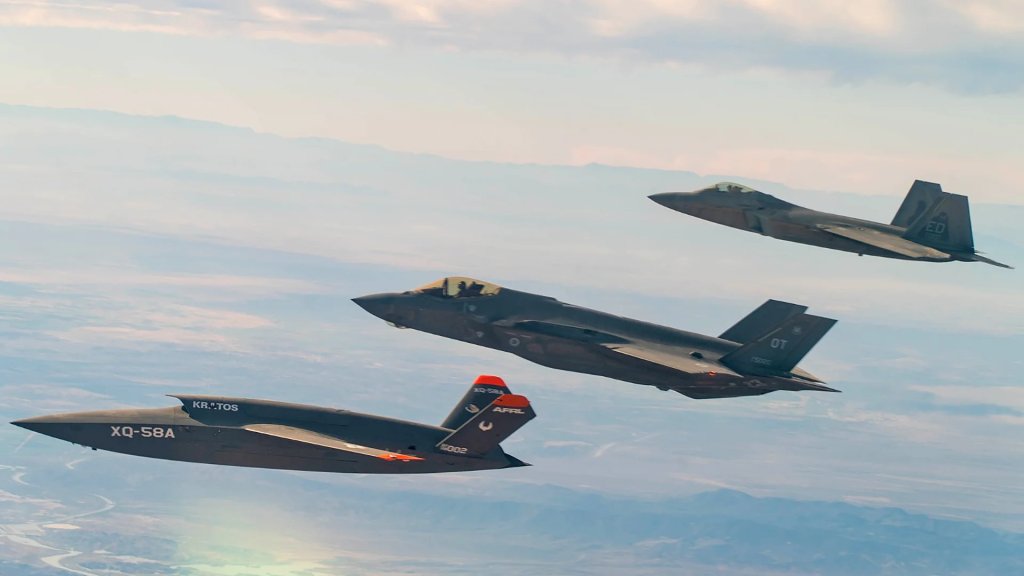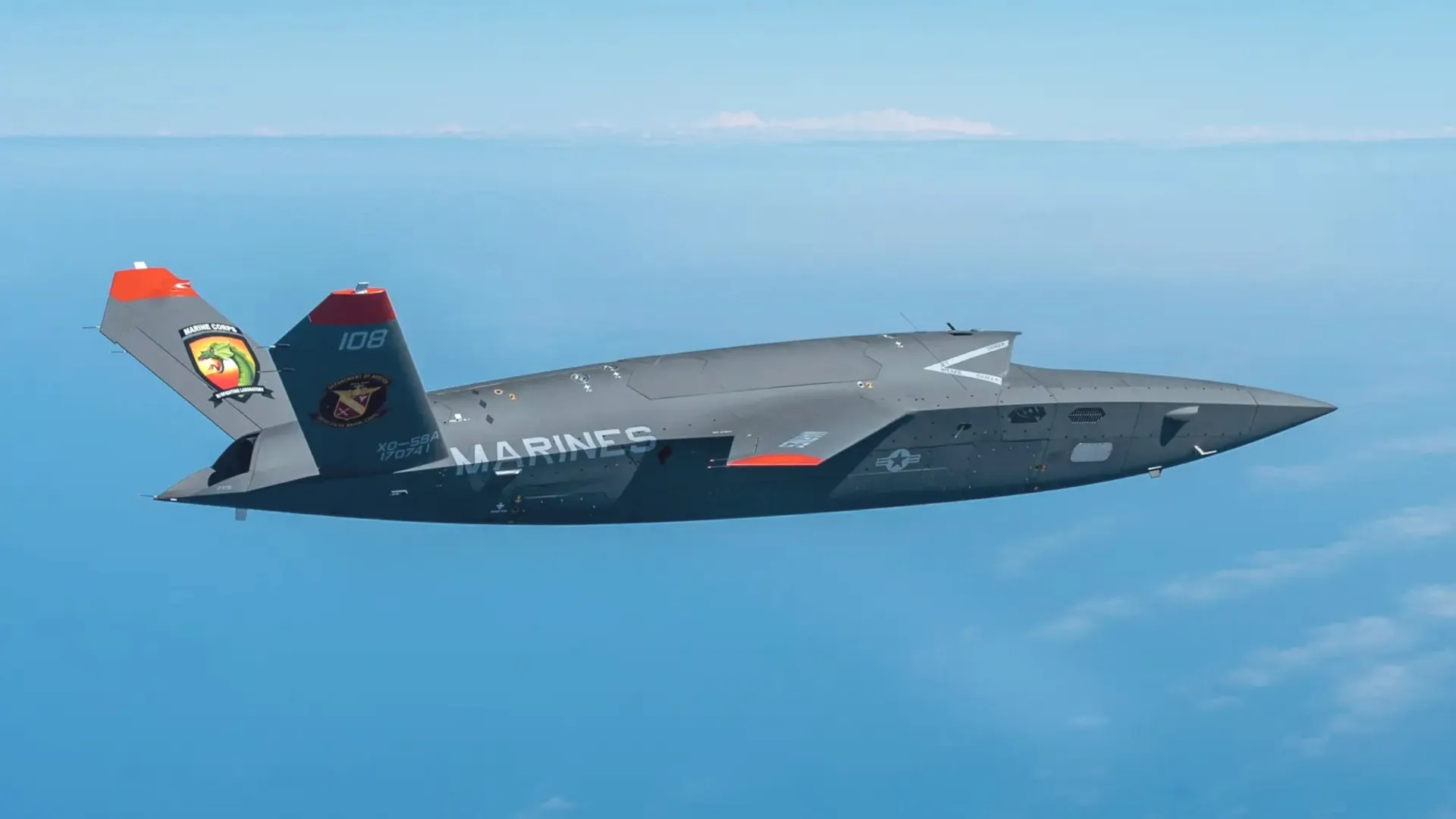A new version of the stealthy XQ-58 Valkyrie with built-in landing gear is in the works the drone’s manufacturer Kratos has disclosed. The addition of internal landing gear points to a potentially larger, heavier, and higher-performance derivative of the XQ-58 that could be better positioned to meet the requirements of the U.S. Air Force’s Collaborative Combat Aircraft (CCA) program and compete for other opportunities.
Eric DeMarco, Kratos’ CEO, confirmed the development of the landing gear-equipped version of the XQ-58 during a quarterly earnings call earlier today. “Very soon we’re going to have a Valkyrie with its own internal gear, which will also have internal weapons, flying,” he said.
Kratos had previously announced that a third launch and recovery method for the Valkyrie was on the horizon, but without providing specific details. The drone was originally designed to be entirely runway-independent, getting into the air using a static ground-based launcher with the help of expendable rocket boosters and then using a parachute recovery system at the end of a sortie.


Last month, the company also announced that it had developed a special launch trolley that allows existing Valkyries without built-in landing gear to make use of traditional runways. While being able to operate without the need for a runway has definite advantages, it does impose limits on takeoff weight and, by extension, on range and payload capacity.

“We’re definitely giving the different customers who have different priorities options,” DeMarco added during today’s earnings call. “We will have the entire [Valkyrie] portfolio flying, demonstrated, for the various customer[s].”
DeMarco did not say which customers or potential customers specifically prompted the development of the new Valkyrie version with landing gear.
“Valkyrie is now in source selection on certain opportunities. So, I am not able to make any specific program opportunity or customer-related comments on Valkyrie at this time,” he explained. “I can say that we have completed our planning for the next serial production run of Valkyries, including with our key suppliers. And we are ready to move forward once we have certain additional information on the potential opportunities, including the final version and capability mix of the aircraft.”
The new production lot of Valkyries will be the third to date. Kratos has also previously disclosed the existence of at least five different Valkyrie variants. This includes a “Block 2” runway-independent version able to fly further and higher, and with a heavier overall weight, than the baseline type. Existing XQ-58s can carry weapons and other stores in an internal bay, as well as a single hardpoint under each wing.

There are currently only two known XQ-58 operators, the U.S. Air Force and the U.S. Marine Corps, both of which have been operating their examples in the runway independent mode in a very limited capacity for test and evaluation purposes. Kratos and the Marine Corps have both talked about plans to operationalize Valkyrie for that service, including as an electronic warfare platform intended to work very closely with crewed F-35B Joint Strike Fighters, as you can read more about here.

The War Zone has noted in the past that the XQ-58’s runway independence would be highly advantageous for the Marine Corps. For some years now, the service has been developing and refining new expeditionary and distributed concepts of operations with a particular focus on island-hopping scenarios in the context of a potential future high-end fight in the Pacific against China. The service’s short takeoff and vertical landing capable F-35Bs can already operate from locations that other fighters can’t, so a drone that does not need a traditional runway would be an ideal companion.

As already noted, the addition of landing gear, especially for a version of Valkyrie that is still able to carry weapons and other stores internally, points to a derivative that will likely be larger and heavier than existing variants. The new XQ-58 version with built-in landing gear could also be higher performance as a result.

Though the Air Force’s CCA requirements remain closely guarded, what has emerged so far has pointed to a demand, at least initially, for greater performance than is offered by existing XQ-58 variants. Given its history with work on Valkyrie and other drones for the Air Force, it was still curious that Kratos was absent from the competition to build the first tranche of CCA drones.
However, the company has expressed a clear interest in taking part in the CCA program’s planned future iterative development cycles, or increments. In April, General Atomics and Anduril were selected to move ahead in the first increment of the program, and there is a possibility that both designs could ultimately go into production. The Air Force’s goal is to kick off the second increment sometime in the 2025 Fiscal Year, which starts on October 1 of this year.
The known CCA performance requirements have also prompted concerns about those drones costing more than expected. The Air Force has said in the past that the goal is for each of the Increment One drones to have a price tag between one-quarter and one-third of that of an F-35 Joint Strike Fighter. Based on publicly available data, this would be between $20.5 and $27.5 million.

“As I mentioned in the prepared remarks, … we remain laser-focused on affordability, attritability, and hitting cost points so affordable mass can really be achieved with things that are flying today, not potentially seven years,” DeMarco said in response to a question in part about the CCA program and its known requirements.
Kratos told The War Zone earlier this year that the unit price range for existing XQ-58 variants is roughly between $4 and $6 million. The company has said in the past that its goal is to drive that down to around $2 million, which would be comparable, if not cheaper price-wise to the cost of many expendable missiles.
Especially given DeMarco’s comments today, there could well be other customers or potential customers for the Valkyrie beyond the Air Force and Marine Corps, including ones outside of the United States. Among those could be parties interested in a more traditional runway-capable arrangement.
Kratos’ full drone portfolio extends well beyond the XQ-58 family, too. This includes the stealthy Thanatos, the first rendering of which was only unveiled last year, and that looks to be a higher-end design than the Valkyrie, as you can read more about here.

“Apollo is now under contract and Athena has been down-selected and is expected to be under contract this quarter,” DeMarco said on today’s earnings call. Kratos has previously disclosed the existence of these two drones as part of its “tactical” portfolio, which also includes the XQ-58 and Thanatos, as well as the UTAP-22 Mako and Air Wolf, but has not provided any details about them to date.

All this being said, the XQ-58 continues to the most visible of Kratos’ “tactical” drone offerings. The newly announced version with internal landing gear, which could be of great interest to the Air Force, shows that work is still being done to significantly expand the scale and scope of capabilities found within the still-growing Valkyrie family.
Contact the author: joe@twz.com
